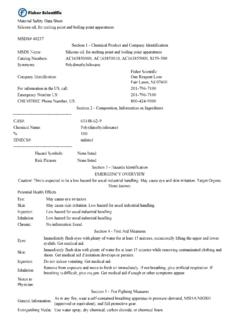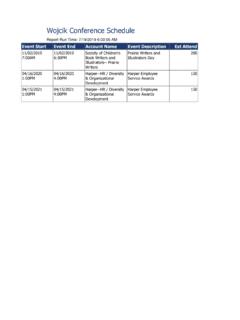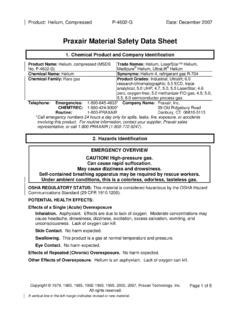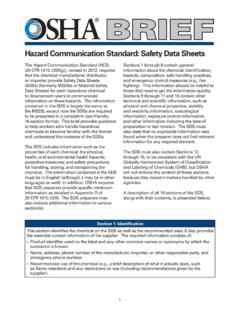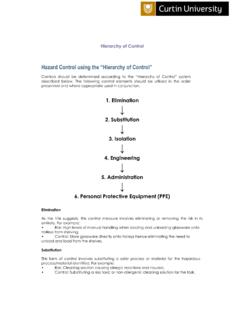Transcription of Mg Material Safety Data Sheet Chemical Name: Magnesium ...
1 P. 1 1 0 1He a lt hFireRe a c t iv it yP e rs o n a lP ro t e c t io n132 EMaterial Safety Data SheetMagnesium MSDSS ection 1: Chemical Product and Company IdentificationProduct Name: MagnesiumCatalog Codes: SLM4408, SLM2263, SLM3637 CAS#: 7439-95-4 RTECS: OM2100000 TSCA: TSCA 8(b) inventory: MagnesiumCI#: Not : Magnesium ribbons, turnings or sticksChemical Name: MagnesiumChemical Formula: MgContact , Smith , Texas 77396US Sales: 1-800-901-7247 International Sales: 1-281-441-4400 Order Online: (24HR Emergency Telephone), call:1-800-424-9300 International CHEMTREC, call: 1-703-527-3887 For non-emergency assistance, call: 1-281-441-4400 Section 2: Composition and Information on IngredientsComposition:NameCAS #% by WeightMagnesium7439-95-4100 Toxicological Data on Ingredients: Magnesium LD50: Not available.
2 LC50: Not 3: Hazards IdentificationPotential Acute Health Effects: Slightly hazardous in case of skin contact (irritant), of eye contact (irritant), of ingestion, Chronic Health Effects:CARCINOGENIC EFFECTS: Not available. MUTAGENIC EFFECTS: Not available. TERATOGENIC EFFECTS: Not TOXICITY: Not available. Repeated or prolonged exposure is not known to aggravate medical 4: First Aid MeasuresEye Contact:Check for and remove any contact lenses. In case of contact, immediately flush eyes with plenty of water for at least 15minutes. Get medical attention if irritation Contact: Wash with soap and water. Cover the irritated skin with an emollient. Get medical attention if irritation 2 Serious Skin Contact: Not :If inhaled, remove to fresh air. If not breathing, give artificial respiration. If breathing is difficult, give oxygen.
3 Get Inhalation:Evacuate the victim to a safe area as soon as possible. Loosen tight clothing such as a collar, tie, belt or waistband. Ifbreathing is difficult, administer oxygen. If the victim is not breathing, perform mouth-to-mouth resuscitation. Seek :Do NOT induce vomiting unless directed to do so by medical personnel. Never give anything by mouth to an unconsciousperson. If large quantities of this Material are swallowed, call a physician immediately. Loosen tight clothing such as a collar,tie, belt or Ingestion: Not 5: Fire and Explosion DataFlammability of the Product: Temperature: Not Points: Not Limits: Not of Combustion: Some metallic Hazards in Presence of Various Substances:Highly flammable in presence of open flames and sparks, of heat. Flammable in presence of acids, of moisture. Non-flammable in presence of Hazards in Presence of Various Substances:Risks of explosion of the product in presence of mechanical impact: Not available.
4 Risks of explosion of the product inpresence of static discharge: Not available. Explosive in presence of acids, of Fighting Media and Instructions:Flammable solid. SMALL FIRE: Use DRY Chemical powder. LARGE FIRE: Use water spray or fog. Cool containing vesselswith water jet in order to prevent pressure build-up, autoignition or Remarks on Fire Hazards: Magnesium turnings, chips or granules, ribbons, are flammable. They can be easily ignited. They may reignite after fireis extinguished. Produces flammable gases on contact with water and acid. May ignite on contact with water or moist fires do not flare up violently unless moisture is Remarks on Explosion Hazards: Reacts with acids and water to form hydrogen gas with is highly flammable andeplosiveSection 6: Accidental Release MeasuresSmall Spill: Use appropriate tools to put the spilled solid in a convenient waste disposal Spill:Flammable solid.
5 Stop leak if without risk. Do not touch spilled Material . Use water spray curtain to divert vapor drift. Prevententry into sewers, basements or confined areas; dike if needed. Eliminate all ignition sources. Call for assistance on 7: Handling and StoragePrecautions:p. 3 Keep away from heat. Keep away from sources of ignition. Ground all equipment containing Material . Do not breathe away from incompatibles such as oxidizing agents, acids, :Keep container in a cool, well-ventilated area. Keep container tightly closed and sealed until ready for use. Avoid all possiblesources of ignition (spark or flame). Moisture sensitive. Dangerous when 8: Exposure Controls/Personal ProtectionEngineering Controls:Use process enclosures, local exhaust ventilation , or other engineering controls to keep airborne levels below recommendedexposure limits.
6 If user operations generate dust, fume or mist, use ventilation to keep exposure to airborne contaminantsbelow the exposure Protection: Safety glasses. Lab coat. Dust respirator. Be sure to use an approved/certified respirator or Protection in Case of a Large Spill:Splash goggles. Full suit. Dust respirator. Boots. Gloves. A self contained breathing apparatus should be used to avoidinhalation of the product. Suggested protective clothing might not be sufficient; consult a specialist BEFORE handling Limits: Not 9: Physical and Chemical PropertiesPhysical state and appearance: Solid. (Metal solid)Odor: : Not Weight: g/moleColor: Silver-whitepH (1% soln/water): Not Point: 1100 C (2012 F)Melting Point: 651 C ( F)Critical Temperature: Not Gravity: (Water = 1)Vapor Pressure: Not Density: Not : Not Threshold: Not Dist.
7 Coeff.: Not (in Water): Not Properties: Not :Very slightly soluble in hot water. Insoluble in cold water. Insoluble in chromium trioxides, and mineral acids, alkalies. Slightlysoluble with decomposition in hot water. Soluble in concentrated hydrogen fluoride, and ammonium 10: Stability and Reactivity Datap. 4 Stability: The product is Temperature: Not of Instability: Heat, incompatible materials, water or moisture, moist with various substances: Reactive with oxidizing agents, acids, : Non-corrosive in presence of Remarks on Reactivity:Violent Chemical reaction with oxidizing agents. Reacts with water to create hydrogen gas and heat. Must be kept with acids to form hydrogen gas which is highly flammable and explosive. Magnesium forms hazardous or explosivemixtures with aluminum and potassium perchlorate; ammonium nitrate; barium nitrate, barium dioxide and zinc; berylliumoxide; boron phosphodiiodide; bromobenzyl trifluoride; cadmium cyanide; cadmium oxide; calcium carbide; carbonates;carbon tetrachloride; chlorine; chlorine trifluoride; chloroform; cobalt cyanide; copper cyanide; copper sulfate(anhydrous),ammonium nitrate, potassium chlorate and water; cupric oxide; cupric sulfate; fluorine; gold cyanide; hydrogen and calciumcarbonate; hydrogen iodide; hydrogen peroxide; iodine; lead cyanide; mercuric oxide; mercury cyanide; methyl chloride;molybdenum trioxide; nickel cyanide; nitric acid; nitrogen dioxide; oxygen (liquid); performic acid; phosphates; potassiumchlorate; potassium perchlorate; silver nitrate; silver oxide.
8 Sodium perchlorate; sodium peroxide; sodium peroxide and carbondioxide; stannic oxide; sulfates; trichloroethylene; zinc cyanide; zinc Remarks on Corrosivity: Not : Will not 11: Toxicological InformationRoutes of Entry: Inhalation. to Animals:LD50: Not available. LC50: Not Effects on Humans: Not Toxic Effects on Humans: Slightly hazardous in case of skin contact (irritant), of ingestion, of Remarks on Toxicity to Animals: Not Remarks on Chronic Effects on Humans: Not Remarks on other Toxic Effects on Humans:Acute Potential Health Effects: Skin: May cause skin irritation by mechanical action. May get mechanical injury or embeddingof chips/particles in skin. The particles that are embedded in the wounds may retard healing. Eyes: May cause eye irritationby mechanical action. Mechanical injury may occur.
9 Particles or chips may embed in eye and retard healing. Inhalation: Lowhazard for ususal industrial handling. It may cause respiratory tract irritation. However, it is unlikely due to physical form. WhenMagnesium metal is heated during welding or smelting process, Metal Fume Fever may result from inhalation of magnesiumfumes. Metal Fume Fever is a flu-like condition consisting of fever, chills, sweating, aches, pains, cough, weakness, headache,nausea, vomiting, and breathing difficulty. Other symptoms may include metallic taste, increased white blood cell is no permanent ill-effect. Ingestion: Low hazard for usual industrial handling. There are no known reports of seriousindustrial poisonings with Magnesium . Ingeston of large amounts of chips, turnings or ribbons may cause gastrointestinaltract irritation with nausea, vomiting, and diarrhea.
10 Acute ingestion may also result in Hypermagnesia. Hypermagnesia maycause hypotension, bradycardia, CNS depression, respiratory depression, and impairment of neuromuscular transmission(hyporeflexia, paralysis).Section 12: Ecological InformationEcotoxicity: Not and COD: Not of Biodegradation:p. 5 Possibly hazardous short term degradation products are not likely. However, long term degradation products may of the Products of Biodegradation: The product itself and its products of degradation are not Remarks on the Products of Biodegradation: Not 13: Disposal ConsiderationsWaste Disposal:Waste must be disposed of in accordance with federal, state and local environmental control 14: Transport InformationDOT Classification: CLASS : Flammable : : Magnesium UNNA: 1869 PG: IIIS pecial Provisions for Transport: Not 15: Other Regulatory InformationFederal and State Regulations:Connecticut hazardous Material survey.


